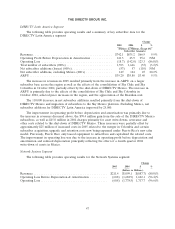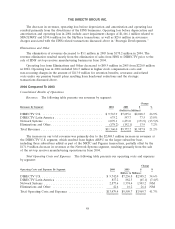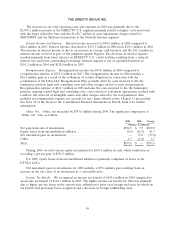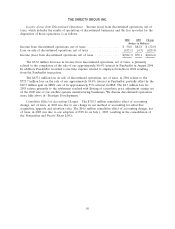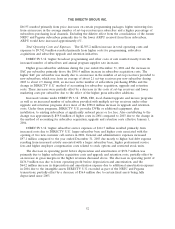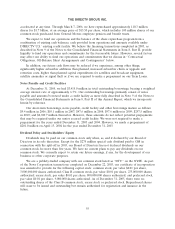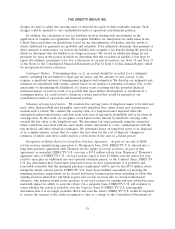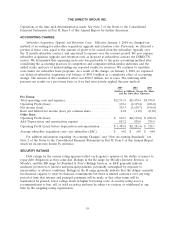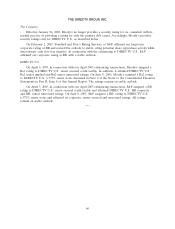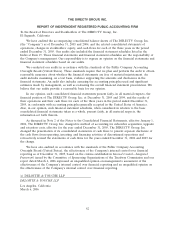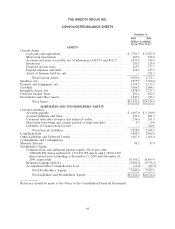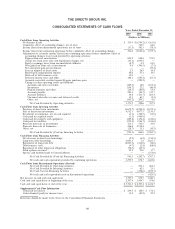DIRECTV 2005 Annual Report Download - page 70
Download and view the complete annual report
Please find page 70 of the 2005 DIRECTV annual report below. You can navigate through the pages in the report by either clicking on the pages listed below, or by using the keyword search tool below to find specific information within the annual report.THE DIRECTV GROUP, INC.
Contingencies
For a discussion of contingencies, see Note 21 of the Notes to the Consolidated Financial
Statements in Part II, Item 8 of this Annual Report, which we incorporate herein by reference.
CERTAIN RELATIONSHIPS AND RELATED-PARTY TRANSACTIONS
For a discussion of ‘‘Certain Relationships and Related-Party Transactions,’’ see Note 17 of the
Notes to the Consolidated Financial Statements in Part II, Item 8 of this Annual Report, which we
incorporate herein by reference.
USE OF ESTIMATES IN THE PREPARATION OF THE CONSOLIDATED FINANCIAL
STATEMENTS
The preparation of the consolidated financial statements in conformity with accounting principles
generally accepted in the United States requires management to make estimates, judgments and
assumptions that affect amounts reported. Management bases its estimates, judgments and assumptions
on historical experience and on various other factors that are believed to be reasonable under the
circumstances. Due to the inherent uncertainty involved in making estimates, actual results reported for
future periods may be affected by changes in those estimates. The following represents what we believe
are the critical accounting policies that may involve a higher degree of estimation, judgment and
complexity. For a summary of our significant accounting policies, including those discussed below, see
Note 2 of the Notes to the Consolidated Financial Statements in Part II, Item 8 of this Annual Report,
which we incorporate herein by reference.
Multi-Year Programming Contracts for Live Sporting Events. We charge the cost of multi-year
programming contracts for live sporting events with minimum guarantee payments, such as DIRECTV
U.S.’ agreement with the NFL, to expense based on the ratio of each period’s contract revenues to the
estimated total contract revenues to be earned over the contract period. Management evaluates
estimated total contract revenues at least annually.
Reserves for Doubtful Accounts. Management estimates the amount of required reserves for the
potential non-collectibility of accounts and notes receivable based upon past experience of collection
and consideration of other relevant factors. However, past experience may not be indicative of future
collections and therefore we could incur additional charges in the future to reflect differences between
estimated and actual collections.
Income Taxes. We must make certain estimates and judgments in determining provisions for
income taxes. These estimates and judgments occur in the calculation of tax credits, tax benefits and
deductions, and in the calculation of certain tax assets and liabilities, which arise from differences in
the timing of recognition of revenue and expense for tax and financial statement purposes. Significant
changes to these estimates may result in an increase or decrease to our tax provision in a subsequent
period.
We assess the recoverability of deferred tax assets at each reporting date and where applicable,
record a valuation allowance to reduce the total deferred tax asset to an amount that will, more likely
than not, be realized in the future. Our assessment includes an analysis of whether deferred tax assets
will be realized in the ordinary course of operations based on the available positive and negative
evidence, including the scheduling of deferred tax liabilities and forecasted income from operating
activities. The underlying assumptions we use in forecasting future taxable income require significant
judgment. In the event that actual income from operating activities differs from forecasted amounts, or
if we change our estimates of forecasted income from operating activities, we could record additional
57


